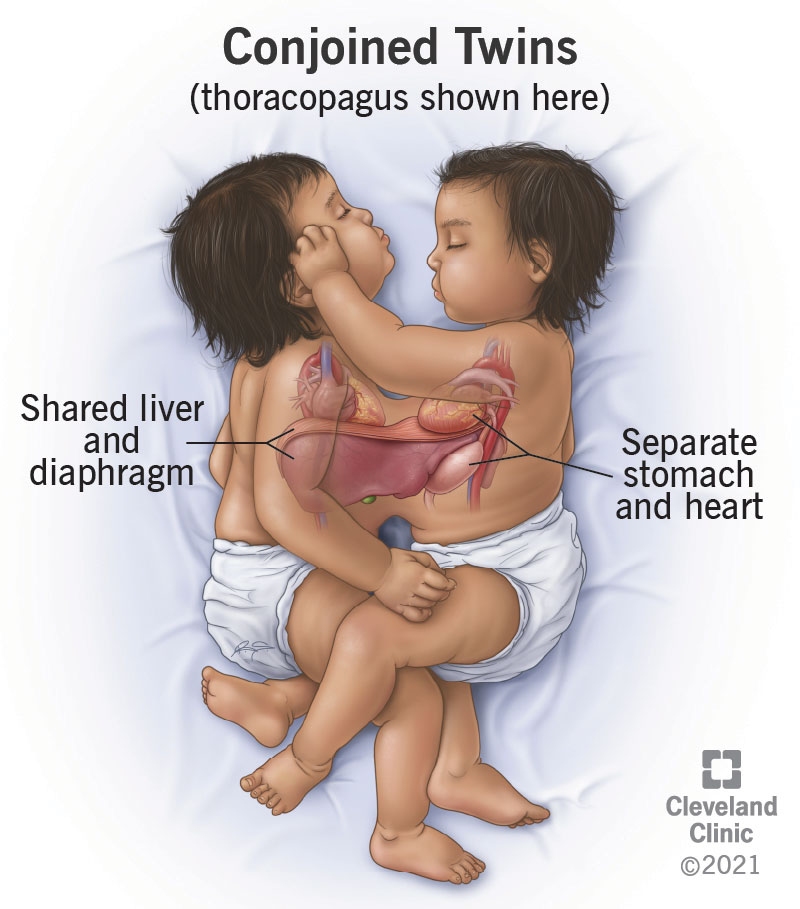Conjoined twins happen when identical twin embryos don’t fully split after fertilization. This creates twins that are physically connected, most commonly at the abdomen and chest. This is a rare condition. Some conjoined twins have separation surgery. Others remain connected for the rest of their lives.
Advertisement
Cleveland Clinic is a non-profit academic medical center. Advertising on our site helps support our mission. We do not endorse non-Cleveland Clinic products or services. Policy

Conjoined twins are twin fetuses that have connected body parts or organs. Conjoined twins are rare. Experts estimate only 1 in every 50,000 to 1 in 100,000 pregnancies involve conjoined twins.
Advertisement
Cleveland Clinic is a non-profit academic medical center. Advertising on our site helps support our mission. We do not endorse non-Cleveland Clinic products or services. Policy
Often, routine prenatal imaging tests show the first signs of physical connections between twin fetuses. The most common point of connection is the twins’ chests and abdomens.
Early detection gives healthcare teams, including specialists, more opportunity to plan treatment. It also gives you time to understand the issues and challenges that come with having twin babies who share physical connections.
In some cases, conjoined twins can have surgery to separate them from each other. Other times, conjoined twins remain linked to each other for a lifetime. In some circumstances, the fetuses may not be able to survive outside the mother’s body. But nearly all conjoined twins will need medical support and care throughout their lives.
Experts know changes that happen during early fetal development lead to conjoined twins. The change happens when something disrupts the process that leads to identical twins. Identical twins happen when a single embryo from one egg and one sperm divide into two embryos that are close together. If an embryo division happens 12 to 14 days after fertilization, the fetal parts may remain connected or conjoined instead of forming two individual but identical twins.
Advertisement
Often, obstetricians detect signs of conjoined fetuses during routine prenatal ultrasounds. An ultrasound may detect conjoined twins as early as the first trimester of pregnancy.
If an ultrasound shows signs of conjoined twins, your obstetrician will refer you to a maternal fetal medicine specialist who manages complicated pregnancies, including conjoined twins.
The specialist may do an MRI to get more information about the fetuses, including the areas of the bodies that the fetuses share. Some common physical connection points are:
Your maternal-fetal medicine healthcare provider will explain what you can expect during your pregnancy and birth. They work with a team that includes:
Your care team will answer your questions and discuss potential options. They’ll also develop a plan for managing conjoined twins’ specific health issues.
The most common complications are miscarriage or stillbirth. Premature labor is very common in pregnancies involving conjoined twins. All babies born early have health risks; those health risks may further complicate care for conjoined twins.
In some cases, it’s possible to separate conjoined twins. Your care team will review imaging tests to identify the areas where the twins’ bodies connect so they can evaluate how separation surgery would affect the babies. In general, the options are:
Advertisement
Your care team will make recommendations for you to consider. They’ll respect your opinions and concerns and work with you to make treatment decisions.
Research shows that about 45% of conjoined twins are live births. But the prognosis — what you can expect — for newborn conjoined twins is poor. Often, one twin won’t live very long after they’re born because they have life-threatening medical issues. Experts estimate that about 8% of conjoined twins survive.
Conjoined twins will need medical support and other care throughout their lives. That’s the case whether they have separation surgery or remain conjoined. For example, conjoined twins may need:
Conjoined twins are rare. You may not know much about the issues involved when prenatal tests show physical connections between twins. Here are some suggestions:
Advertisement
That term dates to the 1800s and the lives of conjoined twins Chang and Eng, who were joined at the sternum. The twins were born in Siam (now Thailand).
No, they can’t. Conjoined twins happen when a single identical twin embryo doesn’t fully divide into two. Just like identical twins, conjoined twins are always the same sex. About 70% of all conjoined twins are female.
If your pregnancy involves conjoined twins, you’re probably familiar with the medical term “points of connection.” It’s the term that healthcare providers use to describe where conjoined twins’ bodies connect. But parents of conjoined twins may experience different types of connection points as they care for their children.
For example, the team of medical specialists answering your questions during pregnancy becomes an essential point of connection. Then, there’s the potential to connect with other parents of conjoined twins. And there’s the connection you’ll develop with the specialists who will be there to help your babies thrive. These are the connection points that you can rely on throughout pregnancy, birth and beyond.
Advertisement
Our fetal surgery program includes leading experts and advanced technology. We perform in utero surgery for tumors, spina bifida and many other birth defects.

Last reviewed on 06/17/2025.
Learn more about the Health Library and our editorial process.